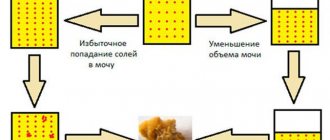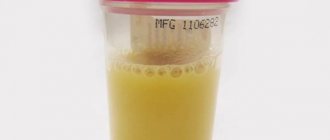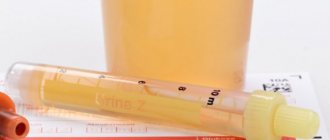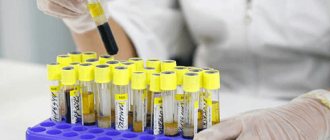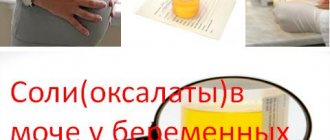Mechanism of protection against stone formation
If there are disturbances in the metabolic process, urine begins to acidify or become alkalized. When the acid-base balance shifts, salts in the urine are converted into crystals. To prevent crystallization, the body produces special antagonist substances. They control biochemical processes and, in case of any disturbances, bind individual components. Elements that have this effect:
- enzymes;
- magnesium ions;
- pyrophosphate compounds;
- citrates.
They prevent crystals from attaching to the mucous membrane of the urinary system (bladder, kidneys, ureters).
Identification of types and forms of stones during analysis
Salts in urine are detected by studying its sediment under a microscope. The conclusion about their properties is made based on the form of crystal localization. But it is worth considering that the substances necessary for the body (antioxidants, electrolytes, some vitamins) can only exist in the form of a salt solution. Without them, biochemical processes and the removal of toxins will be impossible. Therefore, when studying sediment, only insoluble compounds are significant.
If a urine salt test reveals amorphous crystals, preventive therapy is prescribed. Such deposits are not dangerous and cannot provoke the formation of rocky structures. However, they indicate a predisposition to metabolic disorders.
The most commonly identified crystals are:
- oxalates;
- urates;
- phosphates.
Much less commonly formed:
- ammonium urate;
- hippuric acid;
- sulfates + calcium.
Urine analysis provides more information when collecting daily urine. This eliminates changes in the concentration of chemical elements throughout the day.
General urine test for salt
A general urine test for salt is prescribed as a means of diagnosing kidney disorders. The detection of small amounts of salts in isolated cases should not be considered an alarming symptom. However, the first sign of kidney problems is the atypical composition of salt deposits in the urine, which are present in the form of crystals. This or that composition of salts is determined by the acidity of urine. If urine is an acidic medium (its acidity level is less than 5 units), then its sediment contains urates and oxalates. When urine is alkaline (acidity is less than 7 units), oxalates are also detected in the sediment, but phosphates are the most characteristic. For a more detailed study, if problems with the urinary system are suspected, a 24-hour urine test for salts is prescribed.
Daily analysis
A daily urine test helps determine the functionality of the kidneys and determine the amount of substances excreted per day. This prevents the development of diabetes mellitus and urological pathologies.
24 hours before the test, urine is collected in one large container. Such a study can be carried out on people of any age category, even newborns.
Elements that determine the composition of urine:
- water (approximately 97%);
- xanthine, indican, creatinine;
- potassium, sodium, magnesium, phosphorus, traces of calcium;
- uric acid, its compounds;
- phosphates, sulfates, chlorides.
The amount of urine collected is 1-2 liters. Depending on the age and gender of the patient. An accurate interpretation of the analysis is carried out by a specialist.
Preparation
In order for the analysis results to be accurate, it is necessary to prepare for it. 2-3 days before delivery you need to do the following:
- When collecting biomaterial, monitor the hygiene of the external genitalia;
- the day before collecting the analysis, exclude coloring foods (carrots, berries, beets, etc.);
- remove everything spicy, salty, fatty and very sweet from the diet;
- maintain proper drinking regimen throughout the day (at least 1.5 liters);
- do not take synthetic drugs.
If the use of medications cannot be excluded, then you need to inform the laboratory employee about this. Also provide him with information about the name of the medicine, dosage.
How to collect material correctly?
It is necessary to collect material for analysis within 24 hours. Therefore, it is recommended to postpone any trips for this day. Collection rules:
- Prepare a 2-3 liter container with a wide neck and a well-closing lid. It must be pre-sterilized and dried. You can also purchase a special plastic container at any pharmacy chain. Its volume is 2.7 liters.
- Remember the start time of urine collection. Exactly 24 hours must pass between the first and last procedure.
- Wash your genitals well without using products with additives. You can use a weak solution of potassium permanganate or furatsilin.
- When you go to the toilet for the first time in the morning, do not collect urine, just record the time.
- The analysis is first collected in a small sterile and dry vessel and immediately poured into the main container. After this, close the lid tightly.
- After the last urine collection (on the day of the test), mix the material well and pour 150-200 ml into a special jar.
Before collecting material for analysis, you need to ask your doctor how much urine you need to bring. In some cases, a larger capacity may be needed.
Salt drug test
Blood test
Venous blood is used for the study.
A blood test is the most accurate test. There are two ways to carry it out: a quarterly test for antibodies, and a chemical-toxicological test for toxins. The first method is based on the method of detecting antibodies in the blood. Antibodies are produced after the drug enters the blood plasma. The technique is not suitable for testing a person who is currently under the effects of a drug. The quarterly method is not carried out if the person used the drug 1-2 days ago. The reason is that it takes at least 24-48 hours for antibodies to form.
A drug is a collection of low-molecular compounds that lack immunogenic activity. This means that the body does not produce antibodies at the “speed” itself. Complex processes occur in the body that convert drugs into antigens. Antibodies are produced against the antigen, which are determined by the test.
Antibodies remain in the blood for 2-4 months after taking the “salt”. Therefore, the quarterly method can boast of information content and reliability of the result.
Chemical toxicological tests (CTT) are less accurate, but easier to use. They will detect the presence or absence of the drug in the blood plasma. The analysis shows the type of drug and its concentration level. It takes a long time - the results are ready after 8-10 days.
All blood test options require a visit to a medical facility, where a person’s blood is drawn from a vein.
Biological fluid is collected in the treatment room in accordance with sanitary requirements. The procedure is carried out by a doctor who follows the rules of asepsis. It is mandatory to use rubber gloves and treat the puncture site and devices with antiseptic agents.
Saliva analysis
Saliva testing is a simple but not always accurate method. There are three types of saliva testing. Immunochromatographic analysis is an express diagnosis, a simple and fast option. It shows only the presence or absence of a substance in the body
Chemical-toxicological - requires additional medical equipment and is carried out in a hospital. Biomaterial (saliva) is examined in laboratory conditions. This is a qualitative method, not just a quantitative one. It gives not only a positive or negative result, but also indicates the concentration of the substance, period of use, etc. The hardware method is the most accurate and labor-intensive.
Samples are prepared for testing as follows. 10 ml of saliva is collected in a clean, dry plastic or glass container. There may be air bubbles in the saliva; it is important to remove them with a pipette. Air prevents saliva from passing through the absorbents of the dough.
Hair drug test
Hair follicles have an individual blood supply system. The narcotic substance, entering the body, accumulates in all tissues. A hair grows by 1-1.3 cm in 30 days. In this period, information about the substance used is stored. A hair test will allow you to determine what a person consumed 1-3 months ago. Such a study provides information about whether the drug was taken once or continuously.
If you take a hair 3 cm long and cut it into three equal parts, then the part that is closest to the root carries information about all the substances that a person has taken over the past month. The second segment is about substances that entered the body over the previous month. The third segment will talk about substances taken three months ago. If you take a hair 3 cm long and cut it into three equal parts, then the part that is closest to the root carries information about all the substances that a person has taken over the past month. The second segment is about substances that entered the body over the previous month. The third segment will talk about substances taken three months ago.
Kantuev O.I. METHODS FOR DIAGNOSIS OF DRUG DEPENDENCE
What will it reveal?
Daily urine analysis reveals the presence of the same salts as in OAM.
Urats
These are sodium and uric acid salts that have precipitated. Their occurrence in urine is not dangerous. Most often, this occurs when drinking alcohol or eating a poor diet. Urates can also form as a result of heavy physical exertion and systematic fasting.
To bring this indicator back to normal, you need to reduce your alcohol consumption (or better yet, give it up completely) and start eating rationally. Carefully ensure that the body receives all the nutrients it needs.
Phosphates
If there are phosphates in urine, the collected material has a cloudy tint. A burning sensation occurs during urination. This pathological condition indicates the development of cystitis, alkaline diathesis (uraturia).
Oxalates
Elevated levels of oxalates indicate the occurrence of urolithiasis. Sometimes such deposits can be manifestations of infectious pathologies, cystitis, pyelonephritis.
If oxalates are detected in the urine, a repeat test is prescribed. If it gives the same results, the doctor conducts a full diagnostic examination and makes an accurate diagnosis. Only after this the necessary therapy is prescribed.
What can you see in a daily urine test for salt?
Let's look at the most typical results. Please remember: the transcript below is for informational purposes only and in no way replaces medical advice.
Urats
Urates are a precipitate of uric acid salts. If a general urine test for salt reveals urates, then the most likely diagnosis is one of the following: fever, uric acid diathesis, gout or leukemia. The presence of urates may also indicate poor nutrition, in which protein foods and strong tea are consumed in excess. In addition, a similar result is typical for people experiencing excessive physical activity, as well as dehydration or fever.
If no significant diseases are identified, a diet consisting of fruits and vegetables, eggs, dairy products and cereals will help reduce a large amount of urate. It is very important to drink at least two and a half liters of liquid. Alkaline mineral waters (for example, Essentuki or Borjomi) will be especially useful drinks. The body's need for calcium, magnesium, zinc, and vitamins A and B increases.
Phosphates
The appearance of phosphates in test results may indicate cystitis, Fanconi syndrome or hyperparathyroidism, but in some cases it manifests itself when the acidity of urine decreases after a heavy meal in healthy people. If phosphates are present, it is recommended to exclude or at least limit the consumption of foods rich in calcium and vitamin D: fatty fish and fish liver, eggs, high-fat dairy products.
What diseases does the test detect?
The deposition of salts in urine may indicate the formation of:
- Kidney pathologies: pyelonephritis, nephritis (if urates, oxalates are detected). Concomitant symptoms may include fever, pain in the lumbar region, discomfort when urinating, cloudy urine, nausea and general weakness.
- Urolithiasis (with elevated levels of creatinine and urate). Acute pain occurs in attacks in the lower back, frequent false urge to urinate.
- Diabetes mellitus (with high oxalate content). There is an increased level of glucose in the blood, the patient is constantly thirsty, and the urge to go to the toilet becomes frequent.
- Joint diseases: gout, arthritis (urate is observed not only in urine, but also in the joints). In the affected area, stifling pain occurs in attacks, an inflammatory process and swelling in the joints appears.
Based on the results of a urine test for the presence of salts, an accurate diagnosis cannot be made. Therefore, differential diagnostic methods are additionally prescribed.
Choice of treatment depending on results
When removing excess salts from the body, an integrated approach is required. Conservative treatment will not bring results if you do not start leading a healthy lifestyle and eating rationally. To eliminate crystals, you can also use alternative medicine, but only as part of the main therapy and after the recommendation of your doctor.
Nutrition
To remove excess salt from the body, you need to change your usual diet.
- Drink at least 1.5-3 liters of fluid per day (its volume depends on gender, weight category and physical activity).
- Reduce salt intake (it is advisable to eliminate it completely for the first days, after 2-3 days, consume no more than 1-2 g per day).
- Eat sea salt, as it is healthier than table salt.
You need to eat regularly. Portions should be small. Excluded from the diet:
- fatty and fried, with a high content of spices and seasonings;
- fast food;
- canned and pickled;
- semi-finished products;
- carbonated drinks;
- coffee Tea.
Products with a diuretic effect also help eliminate salts. These include any green vegetables, citrus fruits, beets, and onions. It is best to consume them without heat treatment. You can make juices, salads, or eat them raw from fruits and vegetables.
Folk remedies
To remove salts using folk remedies, you can use regular rice:
- 3 tbsp. l. rice pour 1 liter of cool water. Let it sit overnight. In the morning, drain off the excess liquid and add new liquid. Cook over low heat for 5 minutes. After this, rinse the cereal and put it on the stove for another 5 minutes. Repeat these steps 4 times. The resulting porridge is consumed warm. Approximately 3 hours after preparation.
- Pour 1 tbsp. l. rice with cold water. Let it brew overnight. After this, cook over low heat without adding salt. Eat the resulting porridge on an empty stomach. After this, you can have breakfast only after 4 hours.
This treatment lasts 10 days. During this period, it is necessary to include fruits, dried fruits, and vegetables in the diet.
